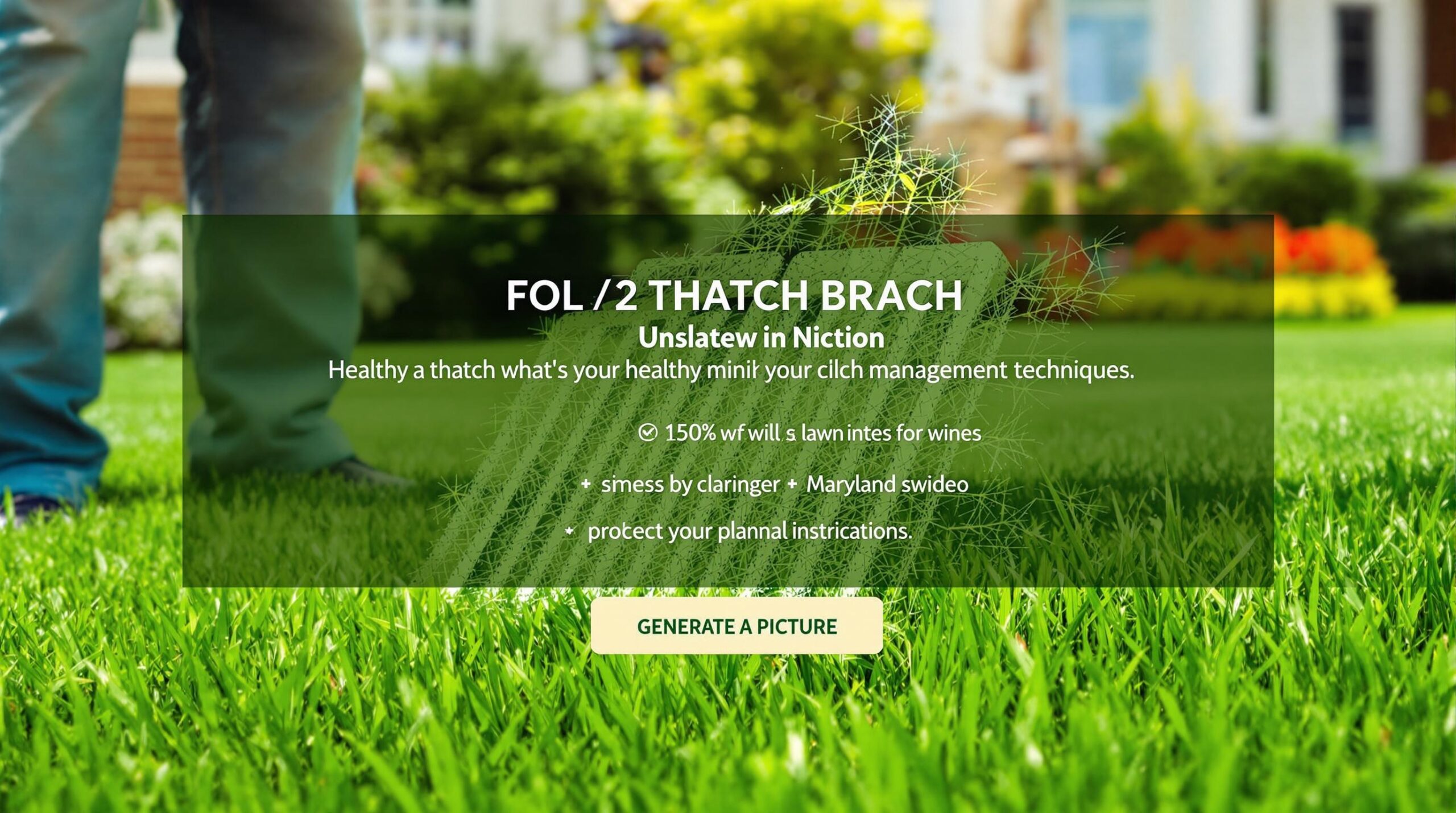- bhavya gada
- No Comments
Too much thatch can ruin your lawn. Thatch is the layer of dead plant material between grass and soil. A thin layer (up to ½ inch) helps retain moisture and insulates your lawn, but anything thicker blocks water, nutrients, and air, leading to weak grass, pests, and diseases.
Here’s how to manage thatch effectively in Maryland:
- Spot Problems Early: Look for sponginess underfoot or water pooling on the surface. Use a trowel to measure the thatch layer – anything over ½ inch is too much.
- Control Methods:
- Aeration: Create holes to improve airflow and nutrient absorption.
- Dethatching: Use a dethatching rake for small areas or a power dethatcher for larger lawns.
- Mowing: Follow correct mowing heights for your grass type to prevent buildup.
- Seasonal Care:
- Spring: Rake and apply pre-emergent herbicides.
- Summer: Fertilize every 5–6 weeks, but skip August.
- Fall: Dethatch and aerate cool-season grasses in early September.
- Winter: Clear debris to prevent buildup.
Need help? Professional services like Pro Landscapes MD can assess and fix severe thatch problems with expert tools and tailored plans.
Managing thatch year-round keeps your lawn healthy, strong, and pest-free.
When to DETHATCH a LAWN and HOW to do it EASY!
Spotting Thatch Problems
The first step to managing thatch issues is recognizing them early – before they start affecting the health of your lawn.
Warning Signs
Here are a couple of signs that your lawn might have a thatch problem:
- A spongy or bouncy feeling underfoot, which often points to thatch buildup.
- Water sitting on the surface instead of soaking in, indicating poor drainage.
If you notice these, it’s time to check the thickness of your thatch layer.
Measuring Thatch
Follow these steps to check if thatch is becoming an issue:
- Use a trowel or spade to remove a small turf sample that includes grass, the thatch layer, and soil.
- Look for the brown, fibrous layer between the grass and soil – this is the thatch.
- Measure the thickness of this layer with a ruler. If it’s more than ½ inch, there’s too much thatch.
- Repeat this process in several parts of your lawn to get a reliable measurement.
This simple check can help you determine if your lawn needs attention.
Thatch Control Methods
Effectively manage thatch in Maryland lawns using these methods.
Lawn Aeration
Core aeration involves creating small holes in your lawn to let air, water, and nutrients pass through the thatch and reach the roots. For warm-season grasses like Bermudagrass and Zoysiagrass, aerate in June. Aerating in July can also help reduce soil compaction. For lawns with thicker thatch, follow up with removal methods.
Removal Techniques
When thatch builds up beyond ¾ inch, mechanical removal is often required. Here are two options:
- Power Dethatching: A power dethatcher (vertical mower) works well during the grass’s active growth phase in June. This timing allows the lawn to recover quickly from the stress of dethatching.
- Manual Dethatching: For smaller areas, use a dethatching rake. Follow these steps:
- Work on slightly moist soil – avoid wet conditions.
- Rake in multiple directions to remove as much thatch as possible.
- Clear away the loose material after raking.
Basic Lawn Care
Support aeration and dethatching efforts with regular lawn maintenance.
- Mowing: Never cut more than ⅓ of the grass blade at a time.
- Ideal Mowing Heights:
| Grass Type | Mowing Height |
|---|---|
| Bermudagrass | 1–2 inches |
| Zoysiagrass | 1.5–2.5 inches |
- Timing: Avoid dethatching during the hottest, driest parts of summer. Early summer provides better conditions for grass recovery after these activities.
sbb-itb-843f8be
Year-Round Thatch Care
Taking care of thatch requires consistent attention throughout the year, tailored to your grass type and Maryland’s changing seasons.
Spring Tasks
Spring kicks off thatch management in mid-March. Here’s what to focus on:
- Deep Raking: Clear out winter debris and check for thatch buildup.
- Pre-Emergent Herbicides: Apply between March 15–April 1 in Central and Southern Maryland, and April 1–15 in Northern and Western Maryland.
As summer nears, shift to practices that promote steady, healthy lawn growth while keeping thatch under control.
Summer Care
Maryland’s hot, humid summers can be tough on lawns. Adjust your approach to keep stress levels low.
Key summer tips:
| Activity | Recommendation |
|---|---|
| Fertilization | Apply every 5–6 weeks; skip August |
| Weed Control | Use spot treatments |
If your grass goes dormant during the peak heat, water it every 2–3 weeks to keep the roots healthy. As the weather cools, get ready to help your lawn recover in the fall.
Fall and Winter Steps
Fall and winter are prime times for tackling thatch, especially for cool-season grasses.
Fall care checklist:
- Early September: Dethatch and aerate cool-season grasses.
- Mid-September: Apply treatments for broadleaf weeds.
- Leaf Cleanup: Remove fallen leaves quickly to avoid matting.
During winter, clearing debris every two weeks can help prevent thatch from building up.
Professional Help
When thatch buildup becomes excessive, calling in the pros can fix the issue and keep your lawn in great shape. Below, we’ll break down the advantages of professional services, what to expect, and how to get a quote.
Why Choose Professional Services?
Hiring a professional lawn care service comes with several perks for tackling serious thatch problems:
| Advantage | Details |
|---|---|
| Proper Tools | Use of high-quality, commercial dethatching equipment |
| Skilled Evaluation | Accurate measurement of thatch depth and overall lawn condition |
| All-In-One Care | Integration with other treatments like aeration and fertilization |
| Time-Saving | Efficiently covers large areas with precision |
If your lawn has a heavy thatch layer, professionals can address the issue effectively while promoting long-term health.
Pro Landscapes MD: What They Offer

Pro Landscapes MD specializes in managing thatch as part of their lawn care services. Their method includes:
- Thorough Assessment: They evaluate the extent of thatch and identify its root causes.
- Customized Plans: Treatments are tailored to fit your lawn’s grass type and specific conditions.
- Integrated Solutions: Services are paired with aeration, drainage, and other maintenance tasks to ensure a healthy lawn.
Their eco-conscious techniques and skilled team also tackle issues like moisture buildup and soil compaction, common problems for Maryland lawns.
How to Get a Quote
If you’re ready to address thatch buildup, here’s how you can get started:
- Reach out to Pro Landscapes MD for a no-cost consultation.
- Arrange a site visit for a detailed evaluation.
- Receive a personalized treatment plan tailored to your property.
You should consider seeking professional help if:
- Your lawn has a thick thatch layer.
- Water isn’t soaking into the soil properly.
- You notice moss or pest issues.
- DIY treatments haven’t worked.
Pro Landscapes MD serves central Maryland, including areas like Howard County and Montgomery County. Their team provides in-depth evaluations and ensures your lawn gets the care it needs with well-timed and effective treatments.
Summary
Managing thatch throughout the year is key to handling Maryland’s specific climate challenges. Keeping thatch levels in check improves water absorption, strengthens roots, and helps your lawn fend off pests and diseases.
Here are the main points for effective thatch management:
- Monitor thatch buildup regularly
- Mow properly and at the right height
- Maintain balanced soil nutrition and pH levels
- Ensure proper drainage to avoid moisture issues
Professional lawn care services offer several benefits, including:
- Expert evaluations of your lawn’s condition
- Tailored maintenance plans based on local grass types
- A thorough approach to treatment and upkeep
Thatch control requires year-round attention:
- Spring: Perform core aeration and assess thatch levels.
- Summer: Keep an eye on thatch and water correctly.
- Fall: Dethatch if needed and overseed to help the lawn recover.
- Winter: Plan and schedule maintenance for the year ahead.
If routine care isn’t enough, professional services can deliver better, longer-lasting results. Pro Landscapes MD specializes in lawn care, landscape design, and drainage solutions. They create personalized plans to address immediate thatch issues while promoting long-term lawn health.


















Chat with Us